warning light MAZDA MODEL CX-9 2020 (in English) Workshop Manual
[x] Cancel search | Manufacturer: MAZDA, Model Year: 2020, Model line: MODEL CX-9, Model: MAZDA MODEL CX-9 2020Pages: 706
Page 219 of 706
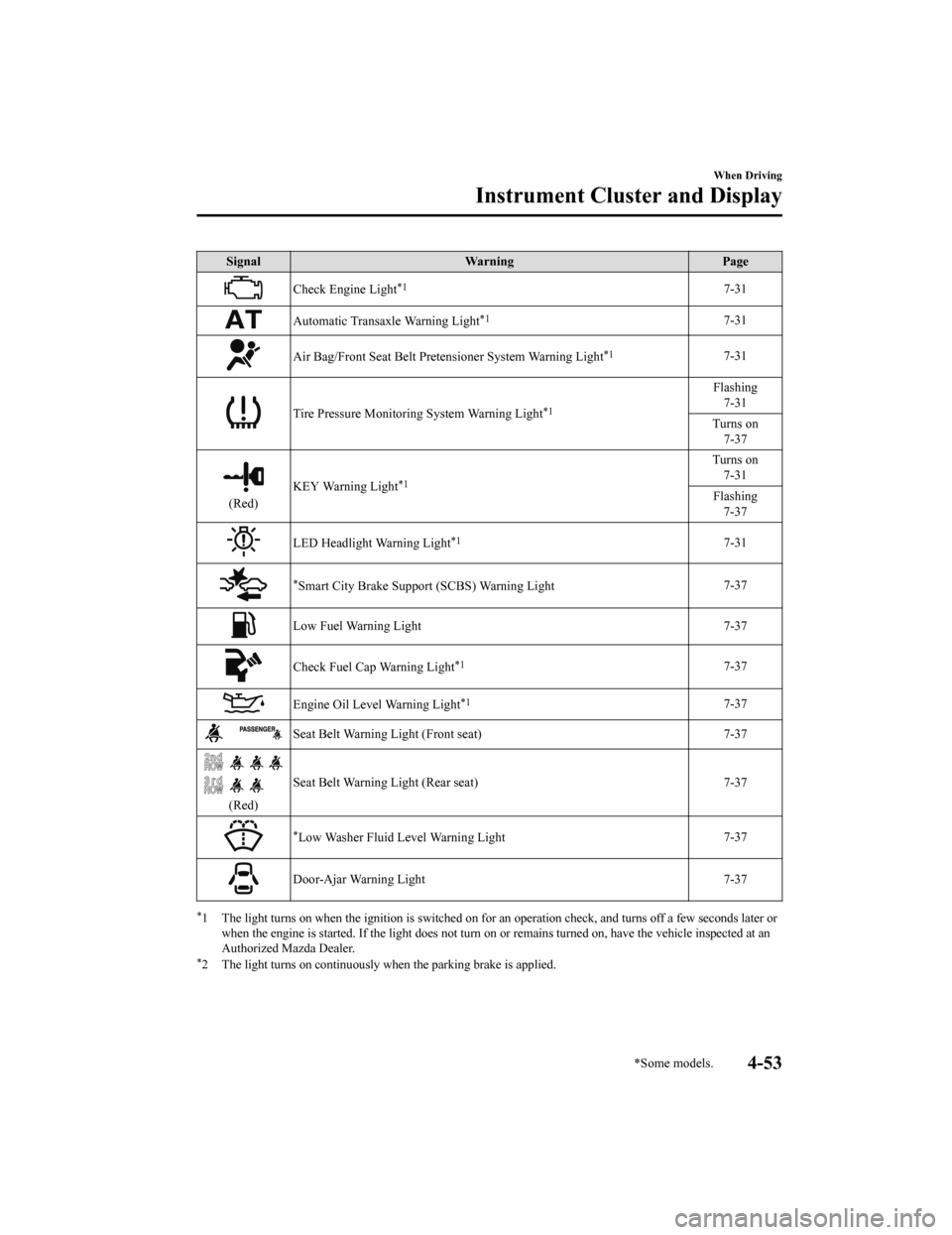
SignalWarning Page
Check Engine Light*17-31
Automatic Transaxle Warning Light*17-31
Air Bag/Front Seat Belt Pretensioner System Warning Light*17-31
Tire Pressure Monitoring System Warning Light*1
Flashing
7-31
Turns on 7-37
(Red) KEY Warning Light
*1
Turns on
7-31
Flashing 7-37
LED Headlight Warning Light*17-31
*Smart City Brake Sup port (SCBS) Warning Light 7-37
Low Fuel Warning Light
7-37
Check Fuel Cap Warning Light*17-37
Engine Oil Level Warning Light*17-37
Seat Belt Warning Light (Front seat) 7-37
(Red)Seat Belt Warning Light (Rear seat) 7-37
*Low Washer Fluid Level Warning Light
7-37
Door-Ajar Warning Light
7-37
*1 The light turns on when the ignition is switched on for an operation check, and turns off a few seconds later or
when the engine is started. If the light does not turn on or remains turned on, have the vehicle inspected at an
Authorized Mazda Dealer.
*2 The light turns on continuously when the parking brake is applied.
When Driving
Instrument Cluster and Display
*Some models.4-53
CX-9_8HT8-EA-19I_Edition2_old 2019-9-24 13:14:55
Page 220 of 706
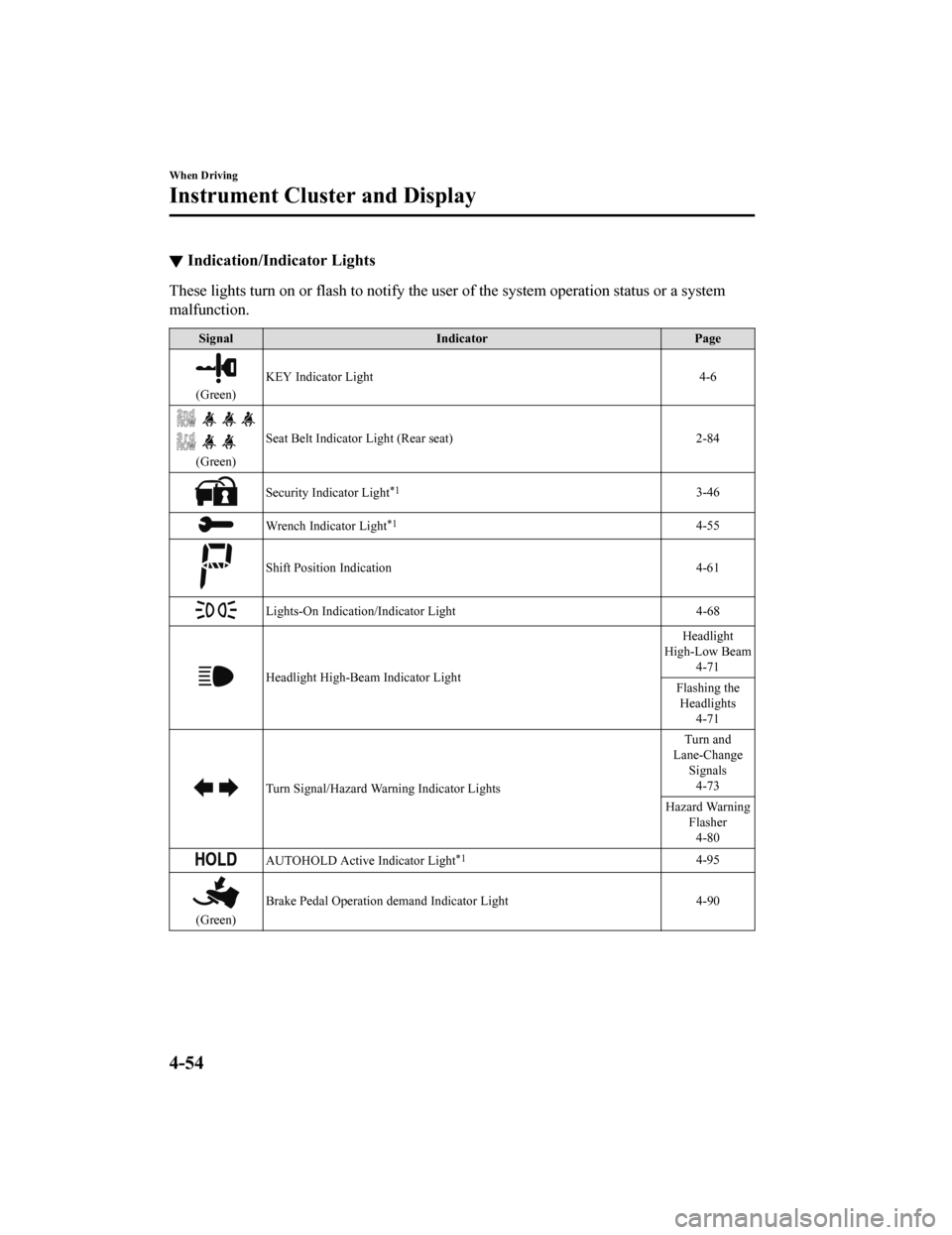
â–¼Indication/Indicator Lights
These lights turn on or flash to notify the user of the system operation status or a system
malfunction.
Signal
Indicator Page
(Green)KEY Indicator Light 4-6
(Green)Seat Belt Indicator Light (Rear seat)
2-84
Security Indicator Light*13-46
Wrench Indicator Light*14-55
Shift Position Indication 4-61
Lights-On Indication/Indicator Light 4-68
Headlight High-Beam Indicator LightHeadlight
High-Low Beam 4-71
Flashing the Headlights 4-71
Turn Signal/Hazard Warning Indicator Lights Turn and
Lane-Change Signals4-73
Hazard Warning Flasher4-80
AUTOHOLD Active Indicator Light*14-95
(Green) Brake Pedal Operation demand Indicator Light 4-90
When Driving
Instrument Cluster and Display
4-54
CX-9_8HT8-EA-19I_Edition2_old
2019-9-24 13:14:55
Page 222 of 706
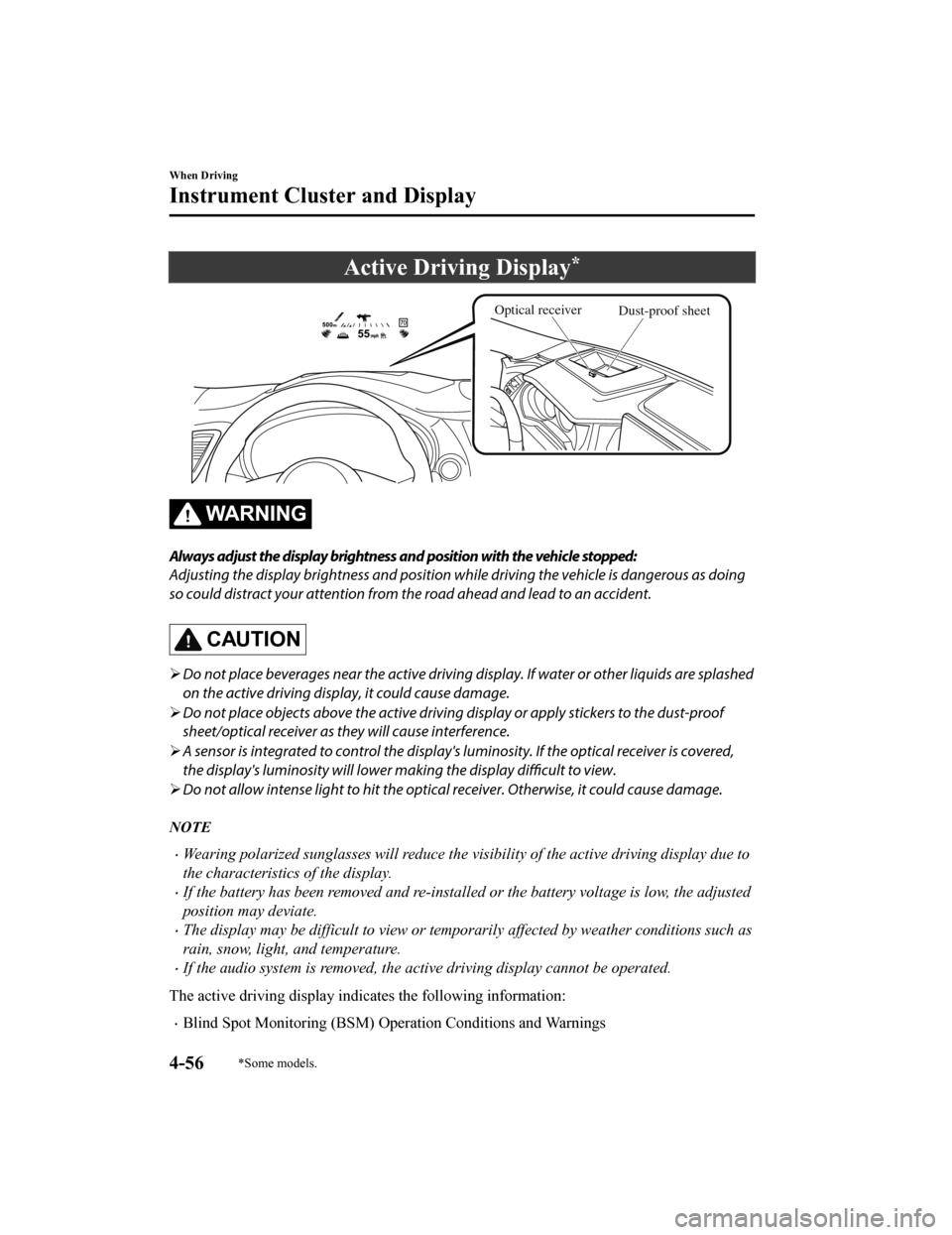
Active Driving Display*
Optical receiverDust-proof sheet
WA R N I N G
Always adjust the display brightness and position with the vehicle stopped:
Adjusting the display brightness and position while driving the vehicle is dangerous as doing
so could distract your attention from the road ahead and lead to an accident.
CAUTION
Do not place beverages near the active driving display. If water or other liquids are splashed
on the active driving display, it could cause damage.
 Do not place objects above the active driving display or apply stickers to the dust-proof
sheet/optical receiver as they will cause interference.
 A sensor is integrated to control the display's luminosity. If the optical receiver is covered,
the display's luminosity will lower ma king the display difficult to view.
 Do not allow intense light to hit the optical receiver. Otherwise, it could cause damage.
NOTE
ï‚·Wearing polarized sunglasses will reduce the visi bility of the active driving display due to
the characteristics of the display.
ï‚·If the battery has been removed and re-installed or the battery voltage is low, the adjusted
position may deviate.
ï‚·The display may be difficult to view or temporarily affected by weather conditions such as
rain, snow, light, and temperature.
ï‚·If the audio system is removed, the active driving display cannot be operated.
The active driving display indica tes the following information:
ï‚·Blind Spot Monitoring (BSM) Op eration Conditions and Warnings
When Driving
Instrument Cluster and Display
4-56*Some models.
CX-9_8HT8-EA-19I_Edition2_old 2019-9-24 13:14:55
Page 246 of 706

Horn
To sound the horn, press the mark on
the steering wheel.
Hazard Warning Flasher
The hazard warning lights should always
be used when you stop on or near a
roadway in an emergency.
The hazard warning lights warn other
drivers that your vehicle is a traffic hazard
and that they must take extreme caution
when near it.
Depress the hazard warning flasher and all
the turn signals will flash. The hazard
warning indicator lights in the instrument
cluster flash simultaneously.
NOTE
ï‚·The turn signals do not work when the
hazard warning lights are on.
ï‚·Check local regulations about the use of
hazard warning lights while the vehicle
is being towed to verify that it is not in
violation of the law.
When Driving
Switches and Controls
4-80
CX-9_8HT8-EA-19I_Edition2_old 2019-9-24 13:14:55
Page 256 of 706
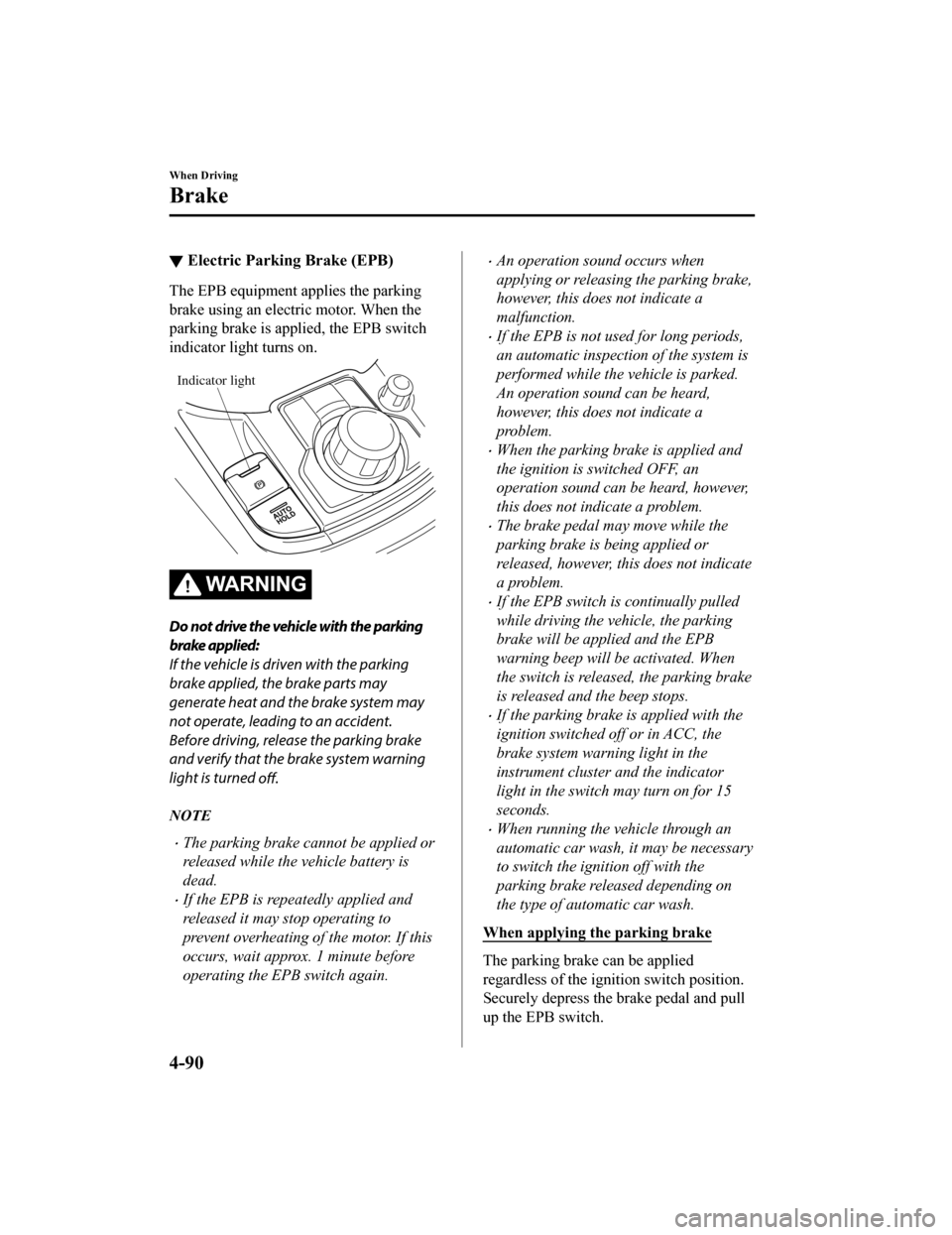
â–¼Electric Parking Brake (EPB)
The EPB equipment applies the parking
brake using an electric motor. When the
parking brake is applied, the EPB switch
indicator light turns on.
Indicator light
WA R N I N G
Do not drive the vehicle with the parking
brake applied:
If the vehicle is driven with the parking
brake applied, the brake parts may
generate heat and the brake system may
not operate, leading to an accident.
Before driving, release the parking brake
and verify that the brake system warning
light is turned
off.
NOTE
ï‚·The parking brake cannot be applied or
released while the vehicle battery is
dead.
ï‚·If the EPB is repeatedly applied and
released it may stop operating to
prevent overheating of the motor. If this
occurs, wait approx. 1 minute before
operating the EPB switch again.
ï‚·An operation sound occurs when
applying or releasing the parking brake,
however, this does not indicate a
malfunction.
ï‚·If the EPB is not used for long periods,
an automatic inspection of the system is
performed while the vehicle is parked.
An operation sound can be heard,
however, this does not indicate a
problem.
ï‚·When the parking brake is applied and
the ignition is switched OFF, an
operation sound can be heard, however,
this does not indicate a problem.
ï‚·The brake pedal may move while the
parking brake is being applied or
released, however, this does not indicate
a problem.
ï‚·If the EPB switch is continually pulled
while driving the vehicle, the parking
brake will be applied and the EPB
warning beep will be activated. When
the switch is released, the parking brake
is released and the beep stops.
ï‚·If the parking brake is applied with the
ignition switched off or in ACC, the
brake system warning light in the
instrument cluster and the indicator
light in the switch may turn on for 15
seconds.
ï‚·When running the vehicle through an
automatic car wash, it may be necessary
to switch the ignition off with the
parking brake released depending on
the type of auto matic car wash.
When applying the parking brake
The parking brake can be applied
regardless of the ignition switch position.
Securely depress the brake pedal and pull
up the EPB switch.
When Driving
Brake
4-90
CX-9_8HT8-EA-19I_Edition2_old 2019-9-24 13:14:55
Page 257 of 706
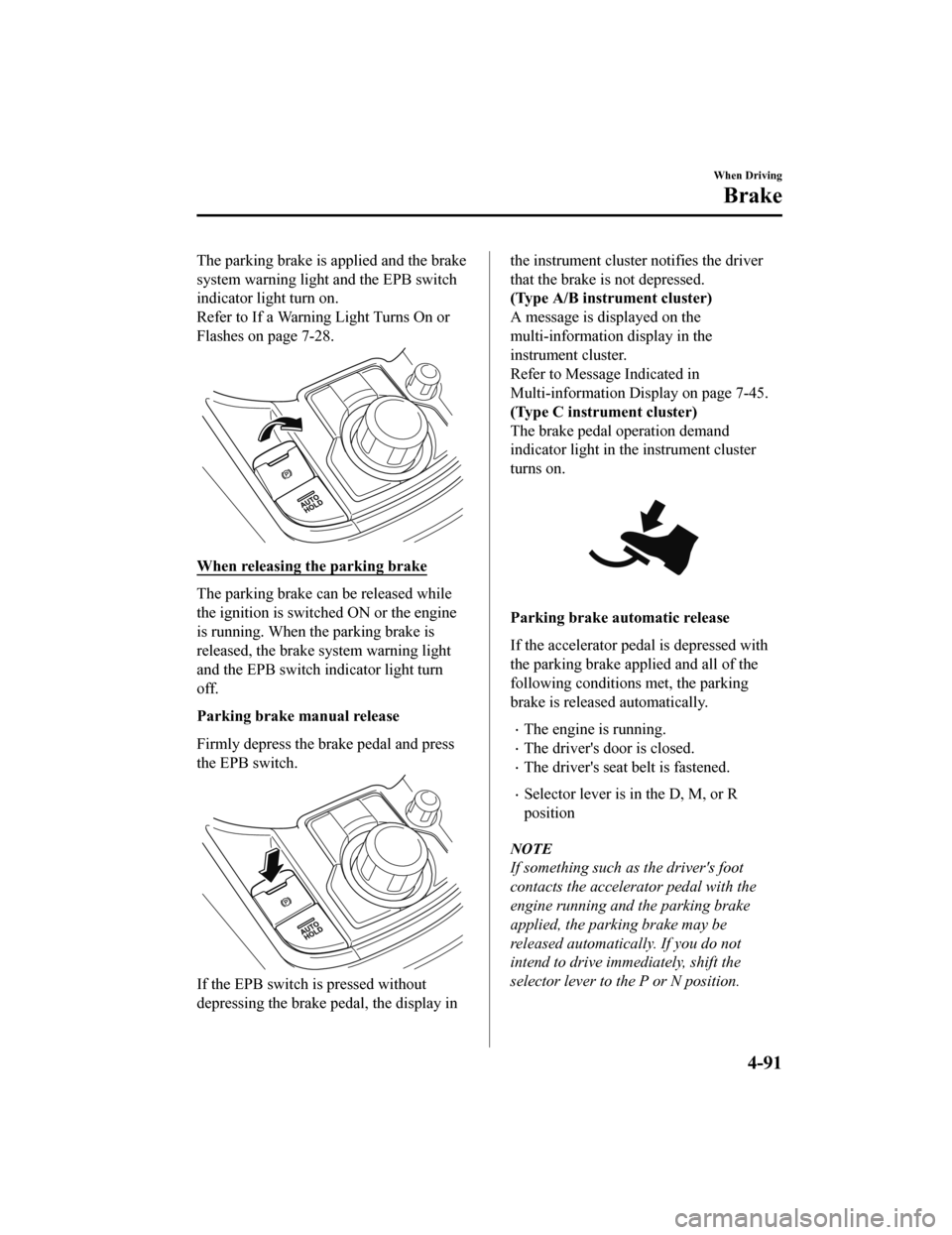
The parking brake is applied and the brake
system warning light and the EPB switch
indicator light turn on.
Refer to If a Warning Light Turns On or
Flashes on page 7-28.
When releasing the parking brake
The parking brake can be released while
the ignition is switched ON or the engine
is running. When the parking brake is
released, the brake system warning light
and the EPB switch indicator light turn
off.
Parking brake manual release
Firmly depress the brake pedal and press
the EPB switch.
If the EPB switch is pressed without
depressing the brake pedal, the display in
the instrument cluster notifies the driver
that the brake is not depressed.
(Type A/B instrument cluster)
A message is displayed on the
multi-information display in the
instrument cluster.
Refer to Message Indicated in
Multi-information Display on page 7-45.
(Type C instrument cluster)
The brake pedal operation demand
indicator light in the instrument cluster
turns on.
Parking brake automatic release
If the accelerator pedal is depressed with
the parking brake applied and all of the
following conditions met, the parking
brake is released automatically.
ï‚·The engine is running.
ï‚·The driver's door is closed.
ï‚·The driver's seat belt is fastened.
ï‚·Selector lever is in the D, M, or R
position
NOTE
If something such as the driver's foot
contacts the accelerator pedal with the
engine running and the parking brake
applied, the parking brake may be
released automatically. If you do not
intend to drive immediately, shift the
selector lever to the P or N position.
When Driving
Brake
4-91
CX-9_8HT8-EA-19I_Edition2_old 2019-9-24 13:14:55
Page 258 of 706
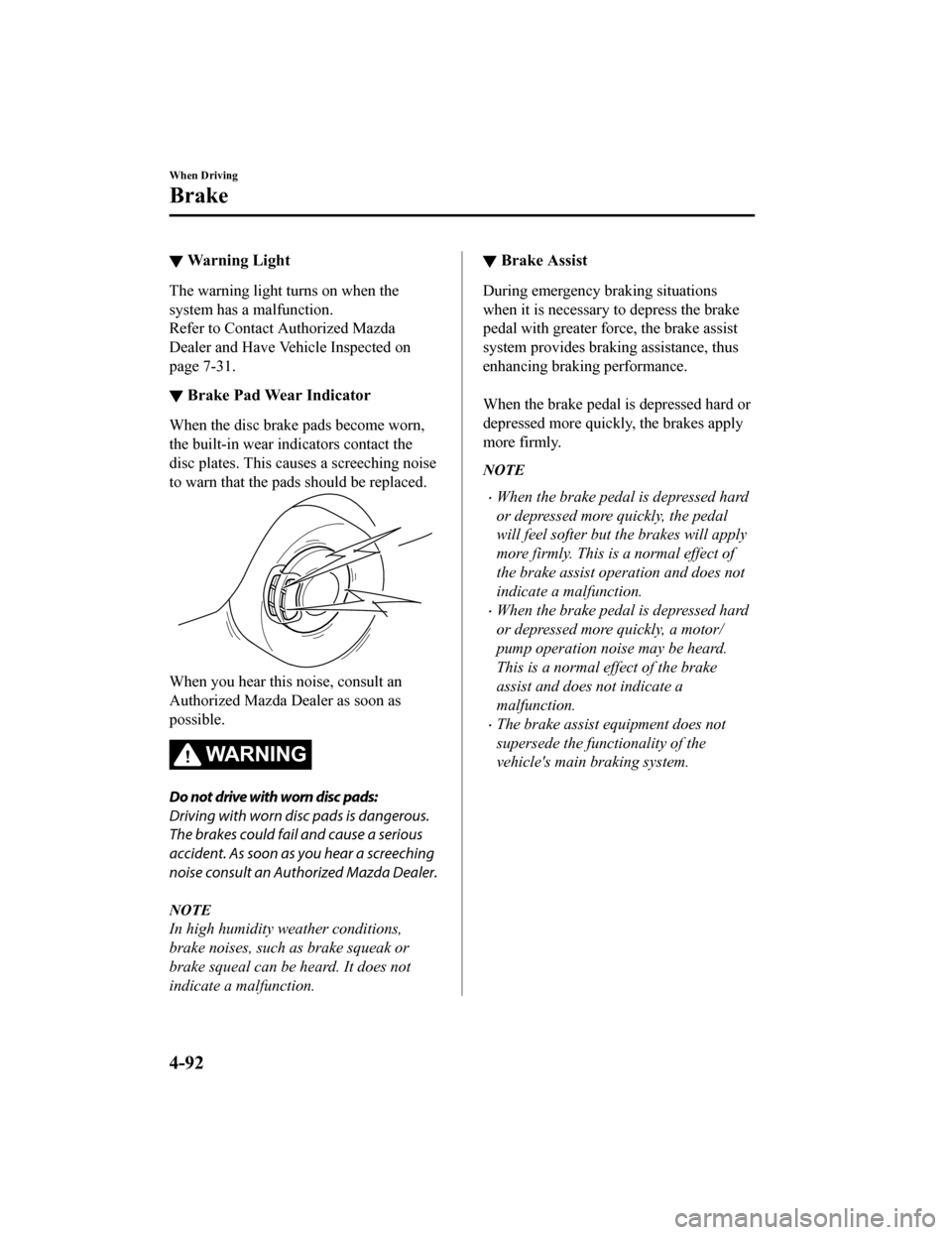
â–¼Warning Light
The warning light turns on when the
system has a malfunction.
Refer to Contact Authorized Mazda
Dealer and Have Vehicle Inspected on
page 7-31.
â–¼Brake Pad Wear Indicator
When the disc brake pads become worn,
the built-in wear i
ndicators contact the
disc plates. This causes a screeching noise
to warn that the pads should be replaced.
When you hear this noise, consult an
Authorized Mazda Dealer as soon as
possible.
WA R N I N G
Do not drive with worn disc pads:
Driving with worn disc pads is dangerous.
The brakes could fail and cause a serious
accident. As soon as you hear a screeching
noise consult an Authorized Mazda Dealer.
NOTE
In high humidity weather conditions,
brake noises, such as brake squeak or
brake squeal can be heard. It does not
indicate a malfunction.
â–¼ Brake Assist
During emergency braking situations
when it is necessary to depress the brake
pedal with greater force, the brake assist
system provides braking assistance, thus
enhancing braking performance.
When the brake pedal is depressed hard or
depressed more quickly, the brakes apply
more firmly.
NOTE
ï‚·When the brake pedal is depressed hard
or depressed more quickly, the pedal
will feel softer but the brakes will apply
more firmly. This is a normal effect of
the brake assist operation and does not
indicate a malfunction.
ï‚·When the brake pedal is depressed hard
or depressed more quickly, a motor/
pump operation noise may be heard.
This is a normal effect of the brake
assist and does not indicate a
malfunction.
ï‚·The brake assist equipment does not
supersede the functionality of the
vehicle's main braking system.
When Driving
Brake
4-92
CX-9_8HT8-EA-19I_Edition2_old
2019-9-24 13:14:55
Page 259 of 706

AUTOHOLD
The AUTOHOLD function automatically holds the vehicle stopped, even if you take your
foot off the brake pedal. This function can be best used while stopped in traffic or at a traffic
light. The brakes are released when you resume driving the vehicle such as by depressing
the accelerator pedal.
WA R N I N G
Do not rely completely on the AUTOHOLD function:
The AUTOHOLD function is only designed to assist the brake operation while the vehicle is
stopped. Neglecting to operate the brakes and relying only on the AUTOHOLD system is
dangerous and could result in an unexpected accident if the vehicle were to suddenly move.
Operate the brakes appr opriately in accordance with the road and surrounding conditions.
Do not release your foot from the brake pedal while the vehicle is stopped on a steep grade:
Because there is a possibility of the vehicle no t being held in the stopped position by the
AUTOHOLD function, the vehicle may move unexpectedly and result in an accident.
Do not use the AUTOHOLD function on slippery roads such as icy or snow-covered roads, or
unpaved roads:
Even if the vehicle is held in the stopped posi tion by the AUTOHOLD function, the vehicle may
move unexpectedly and result in an accident. Operate the accelerator pedal, brakes, or
steering wheel appropriately as necessary.
Immediately depress the brake pedal in the following cases:
Because the AUTOHOLD function is canceled forcibly, the vehicle may move unexpectedly
and result in an accident.
 The brake pedal operation demand warning light (red) flashes and the warning sound is
activated at the same time.
(Red)
[Brake Hold Unavailable Depress Brake to Hold Position] is displayed in the
multi-information display and the warning sound is activated at the same time.
When Driving
Brake
4-93
CX-9_8HT8-EA-19I_Edition2_old 2019-9-24 13:14:55
Page 265 of 706
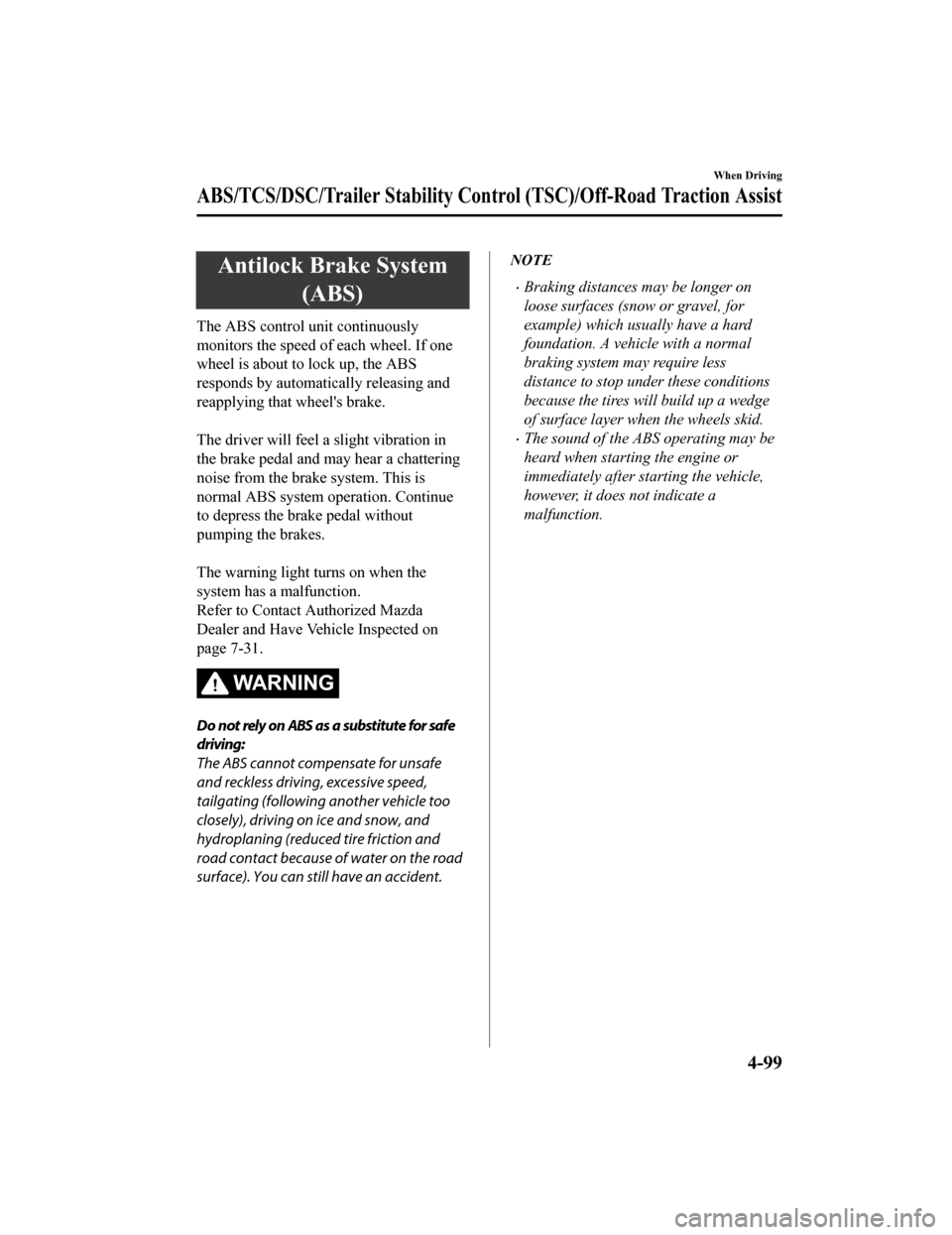
Antilock Brake System(ABS)
The ABS control unit continuously
monitors the speed of each wheel. If one
wheel is about to lock up, the ABS
responds by automatically releasing and
reapplying that wheel's brake.
The driver will feel a slight vibration in
the brake pedal and may hear a chattering
noise from the brake system. This is
normal ABS system operation. Continue
to depress the brake pedal without
pumping the brakes.
The warning light turns on when the
system has a malfunction.
Refer to Contact Authorized Mazda
Dealer and Have Vehicle Inspected on
page 7-31.
WA R N I N G
Do not rely on ABS as a substitute for safe
driving:
The ABS cannot compensate for unsafe
and reckless driving, excessive speed,
tailgating (following another vehicle too
closely), driving on ice and snow, and
hydroplaning (reduced tire friction and
road contact because of water on the road
surface). You can still have an accident.
NOTE
ï‚·Braking distances may be longer on
loose surfaces (snow or gravel, for
example) which usually have a hard
foundation. A vehicle with a normal
braking system may require less
distance to stop under these conditions
because the tires will build up a wedge
of surface layer when the wheels skid.
ï‚·The sound of the ABS operating may be
heard when starting the engine or
immediately after starting the vehicle,
however, it does not indicate a
malfunction.
When Driving
ABS/TCS/DSC/Trailer Stability Control (TSC)/Off-Road Traction Assist
4-99
CX-9_8HT8-EA-19I_Edition2_old 2019-9-24 13:14:55
Page 266 of 706
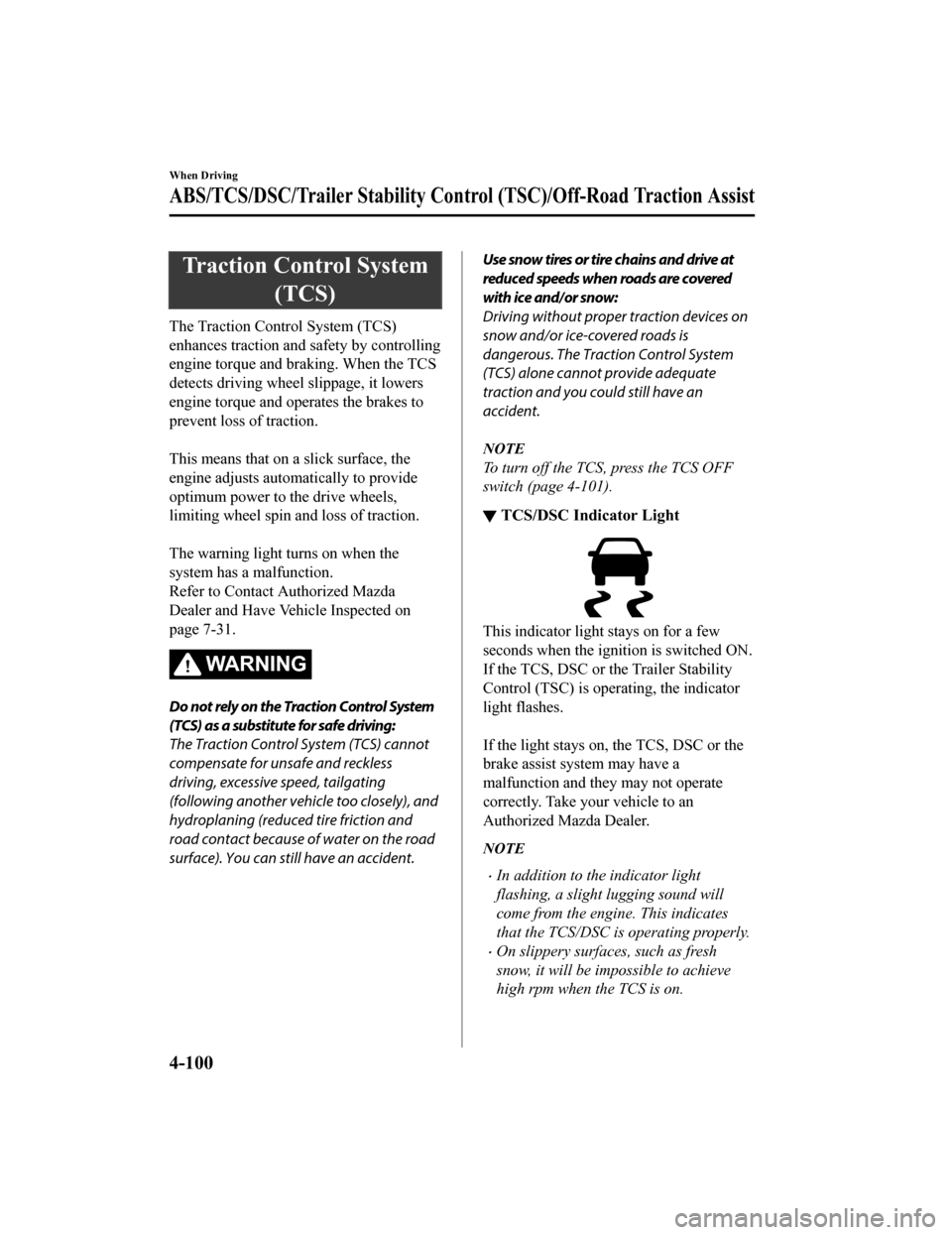
Traction Control System(TCS)
The Traction Cont rol System (TCS)
enhances traction and safety by controlling
engine torque and braking. When the TCS
detects driving wheel slippage, it lowers
engine torque and operates the brakes to
prevent loss of traction.
This means that on a slick surface, the
engine adjusts automatically to provide
optimum power to the drive wheels,
limiting wheel spin and loss of traction.
The warning light turns on when the
system has a malfunction.
Refer to Contact Authorized Mazda
Dealer and Have Vehicle Inspected on
page 7-31.
WA R N I N G
Do not rely on the Traction Control System
(TCS) as a substitute for safe driving:
The Traction Control System (TCS) cannot
compensate for unsafe and reckless
driving, excessive speed, tailgating
(following another vehicle too closely), and
hydroplaning (reduced tire friction and
road contact because of water on the road
surface). You can still have an accident.
Use snow tires or tire chains and drive at
reduced speeds when roads are covered
with ice and/or snow:
Driving without proper traction devices on
snow and/or ice-covered roads is
dangerous. The Traction Control System
(TCS) alone cannot provide adequate
traction and you could still have an
accident.
NOTE
To turn off the TCS, press the TCS OFF
switch (page 4-101).
â–¼ TCS/DSC Indicator Light
This indicator light stays on for a few
seconds when the ignition is switched ON.
If the TCS, DSC or the Trailer Stability
Control (TSC) is operating, the indicator
light flashes.
If the light stays on, the TCS, DSC or the
brake assist system may have a
malfunction and they may not operate
correctly. Take your vehicle to an
Authorized Mazda Dealer.
NOTE
ï‚·In addition to the indicator light
flashing, a slight lugging sound will
come from the engine. This indicates
that the TCS/DSC is operating properly.
ï‚·On slippery surfaces, such as fresh
snow, it will be impossible to achieve
high rpm when the TCS is on.
When Driving
ABS/TCS/DSC/Trailer Stability Cont
rol (TSC)/Off-Road Traction Assist
4-100
CX-9_8HT8-EA-19I_Edition2_old 2019-9-24 13:14:55